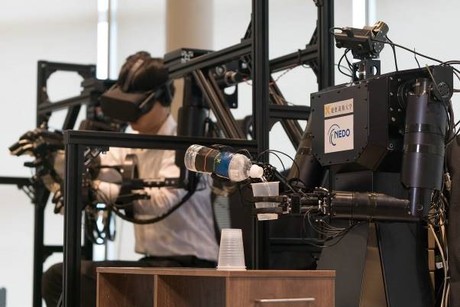Touch-sensitive robot acts as a real-time avatar

Japanese researchers have developed a robotic arm that serves as a real-time avatar for a remotely located user, to whom it transmits sound, vision and highly sensitive feelings of touch. The technology is expected to find applications in areas such as industrial manufacturing, harvesting and nursing.
High-precision robotic arms are widely used in industry, for repetitive actions in automobile assembly lines, for example. However, such robotic arms only repeat a preprogrammed series of commands, grabbing well-defined, solid components used for constructing cars.
The challenge is for robotic arms to be able to recognise the shape, material composition (soft or hard) and position of an object, and manipulate it according to real-time instructions from a user located at a distance from the arm, where the arm acts as a real-time avatar. This could enable their use in applications such as providing care for the elderly in rapidly ageing industrialised nations, supporting labour-intensive agriculture and responding to extreme emergencies where humans cannot intervene directly, such as nuclear power station disasters.
With this in mind, a growing number of researchers are focusing on the potential of ‘haptics’ — man-machine communication based on touch — to solve these and related problems.
In its simplest form, haptics enables users to feel the sense of touch via vibrations of forced motion. The downside is that such technology employs touch sensors that can be difficult to calibrate and often malfunction in extreme environments, such as heat and radiation. Furthermore, conventional haptics technology is based on vibrations and is pseudo-tactile — so, while it can be used for games and entertainment, its range of industrial applications is very limited.
Seeking to change this, Takahiro Nozaki and his colleagues at Keio University’s Haptics Research Center developed a haptic-based avatar-robot with a general-purpose arm (GPA) that transmits sound, vision and movement, as well as highly sensitive sense of touch (force tactile transmission), to a remotely located user in real time. Reported in the journal IEEE Transactions on Industrial Electronics and demonstrated at the Combined Exhibition of Advanced Technologies (CEATEC) 2017, theirs is claimed to be the world’s first high-precision tactile force transmission technology that remembers human movements, edits them and reproduces them.
The robot arm does not employ conventional touch sensors, instead relying on high-precision motors integrated in the avatar arm and algorithms to drive them. High-precision control of force and position is critical for transmitting a sense of touch without using touch sensors. The lack of touch sensors means the robot is cheaper, more compact and more robust with respect to malfunction and noise.

Nozaki and colleagues have gone on to launch ‘Motion Lib’ to commercialise their haptics technology. The main product is an integrated chip called the ABC-CORE IC force/tactile controller, which controls the force adjustment of DC/AC servomotors and forces tactile transmission with two motors synchronised in motion. Importantly, since the load force applied to the motor is calculated by an algorithm in the chip, it is not necessary to install force or torque sensors.
Nozaki has also set up a consortium with 30 companies to undertake proof-of-concept projects for the commercialisation of the technology as an integral part of the Internet of Actions. The assist-avatar robotic GPA is being tested for use in supporting farmers to pick fruit and other agricultural applications.
“This ‘real-haptics’ is an integral part of the Internet of Actions (IoA) technology, having applications in manufacturing, agriculture, medicine and nursing care,” said Nozaki.
Tiny, soft robot flexes its potential as a life saver
Researchers have developed tiny, soft and flexible robots by integrating flexible electronics...
Optical fibre sensor detects arsenic in drinking water
An innovative new optical sensor has been designed to provide real-time detection of extremely...
New haptic patch transmits complexity of touch to the skin
The device, developed by researchers at Northwestern University, delivers various sensations,...





